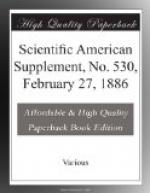In the case of simplicity of construction, it is evident that the simplest and most rational construction is that of a car which depends on itself for its movement, which can move in either direction with equal facility, which can be applied to any existing tramway without expense for altering the road, and the use of which will not throw out of employment vehicles already used on the lines; the electric car fulfilled this condition best, as also the condition numbered 13, as it possessed no boiler.
In respect to No. 14, viz., the ratio of the dead weight of the train to passengers, if we assume 154 lb. as the average weight per passenger, the following is the result in respect of the three cars in which the power formed part of the car:
9,350 lb. Electric car. --------- = 1.78 154 x 34
15,950 lb. Rowan. ---------- = 2.30 154 x 45
22,000 lb. Compressed air. ---------- = 2.55 154 x 56
The detached engines gave, of course, less favorable results under this head.
Under head No. 15 the tractive power of all the motors was sufficient during the trials, but the line was practically level, therefore this question could only be resolved theoretically, so far as these trials were concerned, and the table before given affords all the necessary data for the theoretical calculation.
As regards the rapidity with which the motors could be brought into use from standing empty in the shed, the electric car could receive its accumulators more rapidly than could the boiler for heating the exhaust of the compressed-air car be brought into use.
As regards the steam motors, the following were the results from the time of lighting the fires:
The Rowan—
In 34 minutes 3 atmospheres.
" 36 " 4
"
At this pressure the vehicle could move—
In 40 minutes 8 atmospheres.
The Wilkinson—
In 35 minutes 2 atmospheres.
" 40 " 4
"
" 44 " 6
"
" 47 " 8
"
The Krauss machine required two hours to give 6 atmospheres, which was the lowest pressure at which it could be worked.
The results under No. 17, viz., the fewest interruptions to the daily service, class the motors in the following order: Krauss, electric, Rowan, Wilkinson, compressed air. The chief cause of injury to the compressed air motor arose from the carelessness of the drivers, who allowed the steam boiler to be burnt out. Unfortunately, these drivers were new to the work.
Under the letter C are classed considerations of economy in the consumption of materials used for generating the power necessary for working.
19. Minimum consumption of fuel
(either coke or coal),
in
proportion to the number of kilometers run, and
to
the number of places, assuming for the seats a
width
of at least sixteen inches for each person seated.




